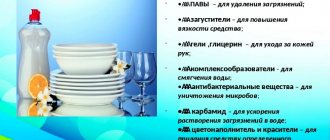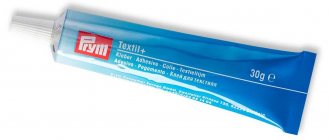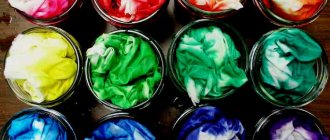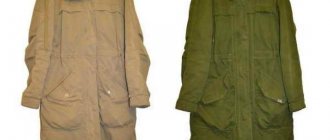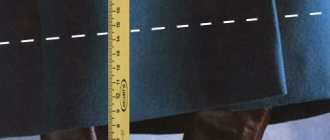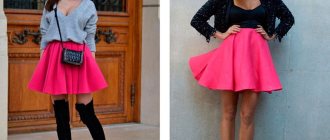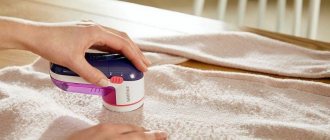The fabric intended for sewing coats is called coat fabric. It can be either dense or light, rough or soft, colored or plain. By composition - natural or with the inclusion of synthetic fibers. Despite the many differences, all types of coat fabric have several common properties. What is the material for coats made of, how are all types similar and how are they different?
A brief excursion into history
The first coats, even slightly similar to modern ones, appeared in the second half of the 18th century. Before this, capes and raincoats made of various materials served as outerwear.
Especially for lovers of horseback riding in England, they began to sew redingotes - long clothes with a high collar and cape. The convenience of this “progenitor” of the coat was appreciated not only by men, but also by women, and it became the most common outerwear for a long time.
Spring coat
In the 19th century, many types of coats came into fashion, named after famous actors or political figures who were among the first to wear them - Chesterfield, Taglioni, Pompadour and others. Particularly popular was the loose, single-breasted sak coat, which was knee-length and had wide sleeves. Men who are fond of sports began to choose a shortened “cover coat” model with a hidden fastener and side vents.
Coats appeared in the ladies' wardrobe already at the turn of the twentieth century, when crinolines and bustles, which complicated the tailoring of outerwear, finally sank into oblivion. The most fashionable styles among the fair sex were considered to be the “Ulster” styles with a high collar and belt and the “taglioni” styles with tapered sleeves and velvet or fur trim.
In the 20s of the last century, the incomparable Coco Chanel completely transformed women's outerwear, adding romance to it. Coats became fitted, they were decorated with embroidery, braid or other original trim.
Each decade of the twentieth century brought new models of warm clothing for men and women to the fashion world. And although in the 80s and 90s the coat was confidently replaced by a variety of down jackets and jackets, it does not lose its position and is still an integral part of the everyday, business or dressy wardrobe.
Drape
In Russian, the term "drape" is used to designate thick woolen fabrics that can be used to sew coats. The quality and characteristics of such fabrics, of course, may vary. There is no short equivalent of the word "drape" in English; the closest analogue is the phrase “thick woollen cloth”.
Drape texture
Requirements for coat materials
A coat, as a rule, is bought or sewn for more than one season, so it is very important that the material for it is not only beautiful, but also has the following quality indicators:
- high level of thermal insulation;
- durability;
- lack of peelability;
- color fastness;
- resistance to stretching and shrinkage;
- ease of care.
Recently, the fashion for summer coats has resumed. The fabrics from which they are sewn must conduct air well and not “float” the body, and also be waterproof and resistant to stains.
What to choose for each season
Different compositions will be relevant at different times of the year. And in order to settle on one option, you need to decide at what time the product will be worn, and for what purpose it is purchased.
For warm summer nights or special occasions, it is recommended to purchase lightweight formulations. The silk group can be used in the summer - it is elegant and light.
For spring/autumn they buy chevron, cashmere, gabardine, and less often jacquard. In winter, the fabric should be denser, able to withstand low temperatures, so drape and tweed are suitable.
If the product is purchased for more than one publication, then pay attention to the wear resistance of the fabric. It should be enough for at least a few seasons.
Classification of coat fabrics
Many materials are used to sew coats. They differ in the composition of raw materials, weaving method, density and dyeing methods. To understand the variety of fabrics, they are classified according to the most important characteristics.
Density
For summer, demi-season or winter coats, fabrics with a certain density are used, which should not exceed the maximum permissible standards:
- for men’s – no more than 650g/m2;
- for women’s – no more than 500g/m2;
- for children - no more than 360g/m2.
Weave type
The appearance of the material and its main characteristics largely depend on the method of joining the fibers. The most common weaves used in coat fabrics are:
- linen;
- twill;
- jacquard;
- finely patterned;
- combined.
In addition, some canvases use a special pile weave. In this way, for example, corduroy reps and corduroy ribbed are obtained.
Coloring and patterns
Coat materials can be plain-dyed, variegated and melange. At the same time, all manufacturers try to use stable dyes that do not fade or fade in the sun.
Various patterns and prints – images printed on the fabric – help to attract attention to the product and emphasize its attractiveness. The most fashionable at present are:
- herringbone or broken strip;
- "chicken foot";
- tiger-leopard colors;
- geometric;
- abstraction.
Two- or multi-color stripes and checks will always be in trend. For women's summer coats, floral motifs are often chosen, and for children's coats, prints with fairy tale or cartoon characters are chosen.
Important fact! For colorful and iridescent coats, you should choose only monochromatic accessories - shoes, a handbag, a hat or a scarf. Otherwise, the image will be too “flashy” and may serve as an object of ridicule.
Raw material type
The level of thermal insulation is one of the most important characteristics for coat fabrics. This indicator is directly related to the type of fibers from which they are created.
Based on the type of raw material, all fabrics for sewing coats are divided into wool and cotton. The first, in turn, have the following subgroups:
- worsted;
- fine cloth;
- rough cloth.
Only after familiarizing yourself with the basic characteristics of materials and studying how to care for them can you make the right choice. Let's take a brief look at the most common coat fabrics.
Properties
These materials are distinguished by significant thickness, density and weight. Mostly they are obtained from wool and wool blends of fine cloth. That is, they are compacted by performing operations such as rolling and napping, which increases the heat-shielding properties. Representatives of the wool group:
Diagonal
Drape
Flannel
Gabardine
Cloth
Tweed
Worsted and coarse cloth coat fabrics are less common. Coat cotton materials are also produced, which are superior in density and thickness to dress and suit materials.
Coat fabrics are characterized by the following types of finishing:
- plain painted: completely painted in one color;
- melange: have a main color interspersed with other shades;
- variegated: a combination of multi-colored threads in the weft and warp;
- bleach: white;
- printed: multi-color designs applied to bleached or plain-dyed fabric.
Woolen and wool blend fabrics
Natural wool retains heat well and provides warmth due to the fact that its fibers have voids inside in which air accumulates. This allows the body to “breathe” freely, which is very important for winter clothing. The material is environmentally friendly, safe, does not cause allergies, does not irritate the skin and does not emit substances harmful to humans. In addition, wool has the following advantages:
- hygroscopicity;
- crease resistance;
- UV resistance;
- low wear and durability.
However, like many natural fibers, wool has significant disadvantages. Over time, it peels - pellets appear, with prolonged wear it can stretch, and after washing it can shrink.
To rid wool fabrics of negative properties, synthetic or artificial threads are added to the fabrics. Most often, lavsan is used for these purposes - its content ranges from 30 to 60% of the total mass of the material.
Viscose or acetate fibers add shine and silkiness to woolen fabrics. To add elasticity and firmness, a small amount of elastane is introduced.
Features of choice
A demi-season coat requires a light but dense fabric base - ideally textured. Cashmere and gabardine are the best options for cool summer or early autumn.
For the rainy mid-autumn, mixed fabrics are suitable - with increased density, strength and water resistance.
In winter, it is better to give preference to soft and cozy fabrics, for example, pile fabrics. Fluffy pile forms an air layer, which increases the heat-saving properties of the material.
How to choose warm fabric for a coat? Watch the video:
Worsted coat fabrics
Such materials have a smooth front surface with a clearly defined weave pattern. Very often they undergo additional treatment with special softeners, antistatic agents and dirt-repellent substances, which significantly improves their consumer characteristics.
Gabardine
Gabardine
This is a fabric in which the threads are intertwined at an angle, forming small scars on the surface. The composition of the fibers can be cotton, wool or mixed. To sew warm coats, 100% wool fabric is used.
The main properties of gabardine are:
- high density;
- softness and drape;
- dimensional stability;
- low wear;
- crease resistance.
It is important to know! When choosing gabardine for sewing a coat, you need to remember that the fabric has increased flowability, which significantly complicates its cutting. In addition, the material is difficult to heat treat.
Thanks to the special weave, the fabric practically does not get wet: drops of water roll off it without getting inside. And gabardine, which has undergone special impregnation, becomes completely waterproof.
Boucle
The material is soft in texture and has numerous large knots on both the front side and the back. It is obtained using linen finely patterned weave of threads.
Boucle is considered a high-status fabric, products from which look business-like and stern at the same time feminine. The material is suitable for sewing ladies' warm and autumn-spring coats.
In addition to wool, boucle may also contain a small amount of acrylic, which increases the strength and elasticity of the fabric. Its advantages over other coat fabrics include:
- volumetric structure that provides excellent breathability;
- good drapability, allowing you to experiment with styles;
- high density makes the fabric practically waterproof;
- crease resistance – even after a long time, folds and creases do not appear.
It is important to know! For all its beauty, bouclé fabric is very whimsical when worn. Its loose structure allows dirt and dust particles to penetrate into the fabric. In addition, elongated loops and puffs can form on the material, which deprive it of its original presentability.
Tweed
This wool fabric, produced by twill or plain weaving, has a characteristic rough surface and is distinguished by a wide variety of patterns. For coats, a tweed-covercoat is most often suitable - a dense material with small splashes of color obtained through the use of melange thread as a weft.
Experts consider real tweed to be a very expensive material made by hand from pure wool of Scottish sheep. For cheaper fabrics, mixed fibers are used, which have the following advantages:
- high degree of heat saving;
- comfort;
- pleasant tactile sensations;
- wear resistance and durability.
Interesting fact! The fabric first appeared in Scotland and is named after the river that flows there. Initially, only men's jackets and coats were made from tweed, but thanks to Coco Chanel, it became a favorite material for women's clothing: all the famous suits and coats for which the fashion house is famous are made from various types of this fabric.
Bobrik
Beaver is a material made from 100% wool with combed standing pile on the front side and a smooth backside. Wool with a high content of downy fibers is used for its production.
The fabric has a significant thickness, up to 4 mm, and has good thermal insulation and windproof properties. Most often it is painted in dark colors - blue, black or brown, although there are melange or light canvases.
The disadvantage of the material is significant creasing of the pile under the influence of moisture. Therefore, a wet coat must be shaken and hung until completely dry.
Like other coat materials, it is better not to wash beaver at home, but to take it to the dry cleaner. If this is not possible, then before you start scrubbing the stains, you should read the description of the recommendations on the label.
Alpaca
Alpacas, domesticated artiodactyl animals bred in the highlands of South America, have unique wool that is used to make the fabric of the same name. The fluff of the cubs is considered the best - thin, even and very gentle. It is from this that one of the most expensive coat materials is made - alpaca baby.
The material has unique properties:
- softness, lightness and silkiness;
- high thermoregulation;
- no rolling;
- water repellency;
- hypoallergenic and safe;
- durability.
Alpaca has no disadvantages other than its incredibly high price, which is why it has been attracting the attention of outerwear designers for several decades. The fabric is famous for its rich range of natural shades - from milky white to blue-black. To make ethnic clothes, the yarn is dyed in bright exotic colors.
Cashmere
The most elite fabric from which you can sew a coat. Its production is made from the undergrowth of a special type of goat living in Mongolia and China. Cashmere threads are 2–2.5 times thinner than human hair, so the material is light, airy and very pleasant to the touch.
Interesting fact! Cashmere fabric is so thin that a scarf or shawl made from it can easily fit through a wedding ring.
The main advantages of cashmere include:
- high warming ability;
- hypoallergenic;
- wear resistance;
- softness and silkiness.
To make a warm winter coat, it is best to find a material that contains 30% cashmere and 70% alpaca. This fabric does not roll, does not wrinkle, and retains its presentable appearance for a long time.
We sew a coat for winter
Sewing a high-quality and comfortable winter coat is not a trivial task. Why? For a coat to be functional, warm, beautiful, and comfortable, it must be a kind of “layer cake.” What layers does the winter range model consist of? We will move from the outside in to consistently study all the necessary materials. 1) The main material is the coat fabric you have chosen, natural, synthetic or mixed. 2) Wind protection and air exchange are incredibly important nuances. No matter how warm and beautiful the coat is, if it is blown through, it’s all lost. You can't wear it in winter. To create a windproof layer, a membrane is often used - a breathable fabric that prevents wind and moisture from penetrating inside. A thin membrane or its analogues directly after the coat layer is an excellent choice if you plan to create something truly warm and comfortable to wear in frosty weather. 3) If in demi-season coats the ability to retain heat in cold weather depends solely on the properties of the main fabric, winter models are sewn with insulation. Today, seamstresses and designers have the opportunity to choose the thickness, insulating properties, density, and weight of insulation, because modern materials, even with minimal thickness, can have exceptional characteristics. Many insulation materials available today to a wide range of buyers do not deform and hold their shape well even without additional stitching. Some insulation materials (for example, woolpon) do not add volume to the product at all, while others (such as padding polyester) make the model “puffy”. We recommend relying on thermal protection indicators, because the functionality of winter outerwear is still a priority when sewing it. 4) Lining - a thin layer of fabric, usually slippery, on a viscose base, which is needed to protect the upper layers from abrasion, to strengthen the structure of the product and for wearing comfort. It's hard to imagine a full-fledged coat without lining! If the coat is long, the lining can be made short, but it should still be present. If you design your future product exactly according to this “layered” pattern, they will definitely delight you all winter.
Fine coat fabrics
For the production of these materials, both pure wool and mixed raw materials are used. Most often viscose, lavsan or acrylic are added. A characteristic feature of the canvases is the presence of a fleecy covering, which can have different heights and densities and completely or partially hide the threads.
Fabrics are produced by plain or twill weave. Pile is added by felting, followed by fluffing and trimming. In most cases, fine wool fabrics are used to sew autumn or spring coats. The most common representatives of this group of materials are drape and cloth.
Drape
Fine cloth drapes are considered entirely wool if the amount of additives in the yarn does not exceed 15%, and half-woolen when synthetic fibers account for more than 50% of the volume. This heavy, dense fabric is produced on machines in which the threads run in several rows. Thus, the drape can have one and a half or two layers of weave.
If the material is produced using threads that differ in color, the result is a melange fabric. Depending on the weave, fabrics with a variety of patterns are produced. They are used to make high-quality men's coats that have a respectable price.
Drape fabrics include the following:
- Velours. Pure wool material made from merino sheep wool. It is distinguished by thick pile, which makes the fabric soft and pleasant to the touch. With prolonged use, it may pill and dry out.
- Ratin. A characteristic feature is the pile, laid in the form of diagonal stripes. It has high wear resistance and gives a pleasant tactile sensation.
- Flacome. To produce this fabric, wool from Merino and Tsigean sheep is used. It also has a ribbed structure, which differs from ratite in the arrangement of the pattern.
All these materials are united by resistance to external influences: due to the thickness and multi-layering, the drape is not blown by the wind and warms in cold weather. In addition, the fabric does not fade from moisture and does not fade in the sun, which allows the products to last for many years.
Cloth
This woolen or half-woolen fabric is easily recognized by its dense, as if whipped pile, in which there are no gaps. To make it, the fluffiest yarn is selected; Merino wool, to which a little sheep or camel fiber is added, is best suited for cloth. This fabric is characterized by the following properties:
- high strength;
- wear resistance and durability;
- waterproof;
- natural and hypoallergenic.
The disadvantage of cloth fabrics is their significant creasing. Get rid of folds and creases using an iron. However, it should be remembered that felt can easily be burned, so the regulator must be set to the “wool” position.
Interesting to know! One of the varieties of material is overcoat cloth - a fabric with amazing properties . It protects against burns and frostbite, wind and rain. It is made using strictly established technology that does not allow even the slightest deviation. The scope of application of this cloth is extensive - military uniforms, clothing for firefighters, metallurgists, chemical industry workers, etc.
Care
To extend the life of your coat, follow a few care tips:
- Avoid folding to prevent the coat from losing its shape. Hangers are the right way to store them.
- After being exposed to rain or snow, dry it, but away from heating appliances.
- For cleaning, use a pellet machine or brush, and for everyday care, a sticky roller is suitable.
- Before you decide to wash, look at the label and model of the coat itself. The product will be damaged if glue was used in it. It is better to entrust this moment to dry cleaning.
- Natural materials absorb odors, so it is worth limiting the contact of perfumes and other cosmetics on the surface.
- Woolen coats are steamed only through a piece of cloth.
Light, sophisticated and elegant fabrics are used to sew women's coats. The men's range is made from coarser, denser ones. Drape is considered a universal option, and a wide selection of its shades and textures will allow you to choose a product in any price category.
© 2022 textiletrend.ru
Cotton coat fabrics
To sew demi-season or light summer coats, thin fabrics based on cotton fibers are used. The most common materials are the following:
- Moleskin. Quite a heavy fabric with a satin weave. It is characterized by high wear resistance and durability. It can be plain-dyed and bleached, sometimes it is treated with special impregnations to create waterproofness.
- Jacquard. To make this beautiful fabric with convex patterns and ornaments, more than 10 multi-colored threads are used. There is one- and two-sided jacquard. Summer coats made from the latter do not need lining.
- Velveteen. Cotton fabric with interesting fleecy stripes. There are two varieties: a thin corduroy rib and a coarser corduroy cord.
- Boiled cotton. The canvas is first subjected to mercerization - treatment in a solution of caustic soda, after which it becomes durable and acquires a noble shine. Women's summer coats are made from this fabric.
Some famous designers offer in their latest collections light and demi-season coats made from suit and even dress fabrics. Outerwear made of tapestry, brocade, satin or satin looks very unusual and creative.
Knowing the characteristics and properties of various materials, it is easier to choose the right fabric for a summer, demi-season or warm coat. And yet, given that these products are not cheap and should last for more than one season, it is better to trust professionals when purchasing or sewing them.
Application
For women's coats, boucle, crepe, and cashmere are used. To create men's outerwear, coarser material is preferable. The ideal materials for children's coats are alpaca and camel hair. Drape is a universal fabric, used for sewing both men's, women's and children's coats. Not every wool material is used to make winter coats. For example, gabardine is more suitable for sewing summer outerwear.
Coat fabrics are used for more than just coats. Thus, uniforms and suits are made from gabardine. Tweed is used to create suits, skirts, and jackets. Felted knitwear is the basis for skirts, jackets, jackets. Diagonal fabric is used to make work clothes and travel equipment.
Now, when you see similar styles of coats, you will not be surprised at the difference in their cost. Just look at the label where the composition of the matter is indicated. What a coat is made of determines its performance. Natural products are always better than synthetic ones, no matter what season they are designed for.
Loden
Loden is a very practical fabric for outerwear. The raw material for loden is usually sheep's wool; sometimes alpaca wool or cashmere and/or polyamide are added to it. The homeland of this fabric is Austria, but it is also made in other countries. Loden has a fleecy surface; it is resistant to water, snow, wind, branches and thorns; in other words, it boasts wear resistance, strength and moisture resistance. In addition, it “breathes” and is also quite easy to clean. Unfortunately, loden coats are very rare these days, but if desired, they can be found and purchased for relatively reasonable money for high-quality outerwear.
Robert W. Stolz loden coat with alpaca wool
The most classic color for loden is dark olive/dark green with a brown tint, but fabrics in other colors are also available. Traditional dark olive loden shows little staining; however, even if they appear, they can usually be removed using a standard clothes brush equipped with stiff bristles. The degree of formality of a Loden coat is usually average; sometimes such coats can look fine even with business suits; successful combinations are often obtained with things made of corduroy and tweed.
Description of species
Woolen coat fabric is a dense material, usually smooth-dyed or melange. Weaving - plain, twill or other. Nylon and other artificial and synthetic materials are used as an additive to wool fibers.
- Tweed is a type of woolen fabric with a special weave of threads, which results in a textured surface. Most often the material has a mixed composition: a combination of wool, viscose and acrylic. It is pleasant to the touch and practical to wear.
- Gabardine is a dense, water-repellent and wrinkle-resistant fabric based on merino wool. The fabric is plain, with a textured ribbed pattern on the surface. Quite hard and friable.
- Camel wool is a natural, warm material with a characteristic light brown color.
- Vigoña is a soft material based on the fur of the animal Vigoña (vicuna). It has a low pile, the texture is loose and fluffy. Vigon is one of the most expensive fabrics.
The modern textile industry offers double-sided fabrics. Each side has certain properties and sometimes differs greatly in composition. There are double-sided fabrics made from the same fibers, differing only in color. For example, double-sided cashmere made in Italy: two layers of material connected by fibers during the production process.
Cavalry twill
This term (cavalry twill) refers to high-quality wool and cotton fabrics with a diagonal and also very dense weave of threads. For coats, of course, only woolen options are used. Good quality classic cavalry twill has excellent wear resistance. Its weight/density may vary; the larger it is, the warmer, of course, the coat will be. As for the degree of formality, cavalry twill can be used to make both a formal and informal product.
Husbands Crombie Coat in Cavalry Twill
Sheepskin (sheep skin)
From sheepskin, that is, sheepskin (shearling, sheepskin), you can sew heavy and very warm winter coats. Their degree of formality is quite low, and not everyone will wear such products with business suits or even with classic mismatched jackets. On the other hand, a sheepskin coat can look quite stylish and have decent matching potential. However, it is worth mentioning that behind every sheepskin item there is a slaughtered animal, while the production of cashmere or wool coats does not involve killing.
Blogger Simon Crompton wearing a Permanent Style x Cromford double-breasted shearling coat
Of course, the quality of sheepskin can vary quite widely. The best examples are very pleasant to the touch and very comfortable. Very high quality hides come, in particular, from properly raised Merino sheep. The best sheepskin coats are made from whole hides, while mediocre ones may actually be made from two layers: suede and wool. We are, of course, talking about integrity in terms of thickness, because it is in principle impossible to make a coat from one single sheep skin: it is too small for this.

